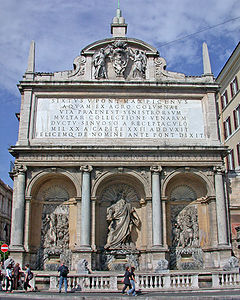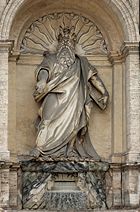
Fontana dell'Acqua Felice
Encyclopedia

Fountain
A fountain is a piece of architecture which pours water into a basin or jets it into the air either to supply drinking water or for decorative or dramatic effect....
located in the Quirinal eDistrict of Rome, Italy. It marked the terminus of the Acqua Felice
Acqua Felice
The Acqua Felice is one of the aqueducts of Rome, completed in 1586 by Pope Sixtus V, whose birth name, which he never fully abandoned, was Felice Peretti. The first new aqueduct of Early Modern Rome, its source is at the springs at Pantano Borghese, off Via Casilina...
aqueduct restored by Pope Sixtus V
Pope Sixtus V
Pope Sixtus V , born Felice Peretti di Montalto, was Pope from 1585 to 1590.-Early life:The chronicler Andrija Zmajević states that Felice's family originated from modern-day Montenegro...
. It was designed by Domenico Fontana
Domenico Fontana
Domenico Fontana was a Swiss-born Italian architect of the late Renaissance.-Biography:200px|thumb|Fountain of Moses in Rome....
and built in 1585-88.
History
At the beginning the reign of Pope Sixtus VPope Sixtus V
Pope Sixtus V , born Felice Peretti di Montalto, was Pope from 1585 to 1590.-Early life:The chronicler Andrija Zmajević states that Felice's family originated from modern-day Montenegro...
(born Felice Peretti) in 1585, only one of the ancient Roman acqueducts which brought water to the city, the Aqua Vergine, was still being maintained and working. Everyone in Rome who wanted clean drinking water had to go to the single fountain near the site of today's Trevi Fountain. Pope Sixtus took on the responsibility of restoring other acqueducts, including the Acqua Alexandrina, which he renamed Acqua Felice
Acqua Felice
The Acqua Felice is one of the aqueducts of Rome, completed in 1586 by Pope Sixtus V, whose birth name, which he never fully abandoned, was Felice Peretti. The first new aqueduct of Early Modern Rome, its source is at the springs at Pantano Borghese, off Via Casilina...
after himself. new fountain that marked the terminus of the restored aqueduct was the first new monumental wall fountain in Rome since antiquity.
The first effort to built the fountain, by architect Matteo Bartolani, was a failure: Bartolani miscalculated the incline of the channel, so the flow of water was much less than needed to supply drinking water for the neighborhood. A new fountain was constructed by architect engineer Domenico Fontana in the form of an ancient Roman triumphal arch. It featured, as ancient Roman fountains did, an inscription honoring its builder, Pope Sixtus. beneath angels holding the papal coat of arms. Within each of the three arches were sculptures on Old Testament subjects. The central arch featured a large statue of Moses
Moses
Moses was, according to the Hebrew Bible and Qur'an, a religious leader, lawgiver and prophet, to whom the authorship of the Torah is traditionally attributed...
, made in 1588 by Leonardo Sormani
Leonardo Sormani
Leonardo Sormani was an Italian sculptor of secondary reputation, originally from Savona, who is recorded as living in Rome from the 1550s until about 1590...
and Prospero da Brescia. To the left is Aaron
Aaron
In the Hebrew Bible and the Qur'an, Aaron : Ααρών ), who is often called "'Aaron the Priest"' and once Aaron the Levite , was the older brother of Moses, and a prophet of God. He represented the priestly functions of his tribe, becoming the first High Priest of the Israelites...
Leading the Israelites to Water, and to the right is Gideon
Gideon
Gideon was an Israelite judge who appears in the Book of JudgesGideon may also refer to:- Religion :* Gideon , a figure in the Book of Mormon* Gideons International, distributor of copies of the Bible- Media :...
Leading His People across the River Jordan sculpted by Flaminio Vacca
Flaminio Vacca
Flaminio Vacca or Vacchi was an Italian sculptor. His sculptural work can be seen in Rome in the grandiose funeral chapel of Pope Pius V designed by Domenico Fontana at the Basilica di Santa Maria Maggiore , in the Church of the Gesù and in the right transept of...
and Pietro Paolo Olivieri. Water flows from the statues into basins, where four Egyptian lions are spouting water.

Protestant Reformation
The Protestant Reformation was a 16th-century split within Western Christianity initiated by Martin Luther, John Calvin and other early Protestants. The efforts of the self-described "reformers", who objected to the doctrines, rituals and ecclesiastical structure of the Roman Catholic Church, led...
, was serving the needs of the people of Rome. It also achieved its social purpose of reviving the Quirinal neighborhood; what had been a rustic area of villas was turned into a thriving urban neighborhood by the arrival of a good drinking water supply.

